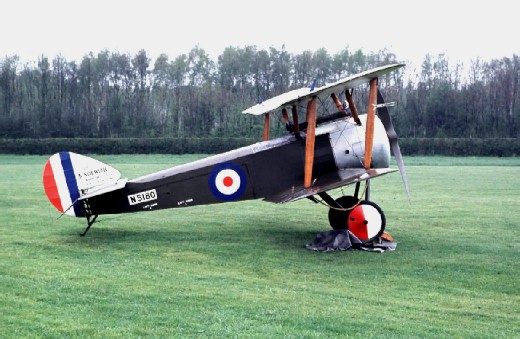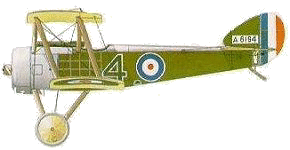|



Pilots who flew faster,
more famous, more sophisticated airplanes have been known to wax poetic
discussing the tiny Sopwith Pup, some even claiming it was the most
perfect flying machine ever made. Objectively, it likely was the most
delightful and easy to fly aircraft of the 1914-18 conflict. Though
underpowered in its 80 h.p. version, it remained sensitive to controls
and fully aerobatic up to 15,000 feet, and could hold altitude better
than any other aircraft of like vintage.
Even the appellation "Pup" reflects the pilots' attitude toward the
aircraft. The Admiralty designator was Type 9901, and several times the
Royal Navy made efforts to stamp out name designators from all
aircraft, especially the little Sopwith, insisting that it be referred
to only by its official nomenclature. The more they persisted, the more
pilots and ground crew called the machine by their favourite title, for
the airframe was thought of as a miniaturized 9700 "1 1/2 Strutter".
Virtually no one ever calls the aircraft anything but "Pup".
The Pup was a classic of simplicity. Each wing carried ailerons, and
there was a large cutout in the trailing edge of the upper centre
section, under which the pilot sat. Quite conventional, the aircraft
was light, and became an even better performer in its later years,
fitted with the 100-h.p. Gnome Monosoupape engine.
The Pup saw its greatest moments over Ypres, Messines, and Cambrai. It
could literally turn twice to the single turn of its Albatros
contemporaries, and though under gunned, its mechanical Sopwith-Kauper
interrupter gear was more reliable than other allied interrupters of
the period, and Pup pilots liked to get very close and finish fights
with minimal misses.
After fighting a Pup in 1916, ace Manfred von Richthofen wrote: "We
immediately understood the enemy machines were superior to our own."
Number Eight Squadron, Royal Naval Air Service, scored twenty victories
in Pups by the end of 1916.
But the Pup lived on for a long time after its front line service. The
100-h.p. version was in use for home defence until the end of the war.
Pups were test beds for all sorts of experimental engines and
associated machinery, and were used to test skid landing gear, arrester
mechanisms, and much of the early carrier landing and takeoff
procedures and hardware. On 2 August, 1917, Squadron Commander E.H.
Dunning landed a Pup on the partially-converted flight deck of the
converted light battle-cruiser H.M.S. Furious, the first ever by a
landplane on a ship actually at sea and under way. Pups continued in
service in diminishing numbers for several years after the war,
primarily with the Royal Navy.
Country: Great Britain
Manufacturer: Sopwith Aviation Company
Type: Fighter
First Introduced: October 1916
Number Built: 1,770
Engine(s): Le Rhône 9C, 9 cylinder, air cooled rotary, 80 hp
Gnome Monosoupape, air cooled rotary, 100 hp
Wing Span: 26 ft 6 in [8 m]
Length: 19 ft 3¾ in [5.86 m]
Height: 9 ft 5 in
Empty Weight: 856 lb
Gross Weight: 1225 lb [555 kg]
Max Speed: 106 mph [161 kmh]
Ceiling: 18,500 ft [563 m]
Endurance: 3 hours
Crew: 1
Armament: 1 Vickers .303 machine gun |
